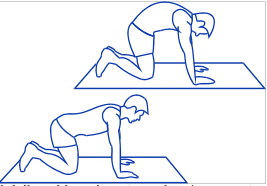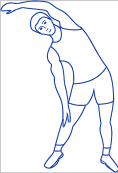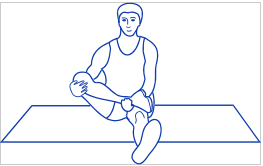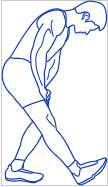An Exercise program for people with Backache

There are certainly many ways of curing backache and surgery should only be the last resort. The key is to make the right diagnosis, exclude potentially harmful underlying pathology and rest the back, only during the acute phase. As soon as the acute pain has settled a strengthening program should be started.
It is also important at this stage to work with your tennis coach to correct bad habits and try to simplify your technique. It is also important to realize that the power in all shots is created by a kinetic chain of events and that the strong leg muscles play an essential role in this aspect. In all cases of back injuries, no matter what the cause, there will be weakening of the stabilizing muscles of the spine. Depending on the underlying pathology and time of rest, the amount of weakening will vary.
The aim in treatment is still to get rid of the pain as quickly as possible with the least invasive methods and to start strengthening the back as quickly as possible. Adequate rest is essential and often special investigations; MRI or radioisotope studies will help to determine the length of the rest period.
Conservative management
1) Medication: Analgesics and Anti-inflammatories
2) Physical: Manipulations, trigger point treatment
3) Rehabilitation program
For years we were all taught to do sit-ups and lately crunches (with knees flexed) to strengthen our backs. It is only recently that we have learned how to strengthen our back-stabilizing muscles properly and how the Pilates techniques complement it. It is still essential for a competitive tennis player to have good abdominal strength.
It is important to focus on the core muscles to prevent and to rehabilitate after back injuries.
Isometric exercises are the best way to achieve our goal of improved core stability. In this way the back facet joints and discs are also protected and inhibition of the muscles due to pain is negated so that rehabilitation can start.
Aerobic exercises also play an important role in the management of backache in the way that the endorphins that are released suppresses pain and facilitate core stability exercises.
A scientific stretching program will decrease the load on the vertebral discs and facet joints.
The emphasis of this column is on the basics of the science and prevention of injuries and therefore all the players are encouraged to work with the coaches, physiotherapists and biokinetisist to find a program that they find interesting and challenging enough to do regularly. It is of no use to have a program that is too complicated to do regularly or cannot be done at home or when the player is on the tour.
For a basic back-strengthening program we will start with:
Multifidus and Transverse Abdominis strengthening The easiest is to be on all fours and contract the umbilicus in the direction of the spine as much as possible, with the lower back slightly flexed and at the same time to focus on elongating the sides. 3 sets of 10 at 10 seconds per exercises must be the aim to do. Initially it will difficult to muscle groups will be difficult to illicit but with training and conditioning will get easier and better.
The extensors of the back (erector spinae) very seldom need too much strengthening but the following exercise is safe, although one must be careful not to hyperextend the back. Once again we start on all fours and with the lower back slightly extended and stabilizers contracted raise/extend the left arm and right leg and keep for 10 seconds. By swapping sides sets of 3 of 8-10 are performed.
Abdominal crunches are limited to 45° and with hips and knees flexed and ankles free. Once again 3 sets of 8-10 10seconds each.
Stretching program
Like any good exercise program we start with a stretching program and we not only focus on the back and abdominals but especially the muscles that control the pelvis and hips. These will most often tighten the quickest and in many cases are often tight and short to start with.
When we do stretches we must be careful not to overstretch, especially the players with a tendency to be ligamentously lax. Stretches must be done on sets of 3 and kept for 20-30 seconds.
The 4 most important stretches for players with backache are:
1- Lateral spine stretches
2- Gluteal and piriformis stretches
3- Quadriceps stretches Either standing or lying postions
4- Hamstring stretches Right and left side seperately and the foot can be rested on a chair
Prevention is better than cure and therefore it is essential that all young Tennis players should follow a proper strengthening and stretching program. Correct training methods; especially in the growing years are important.
I would like to encourage all players to find a strength and conditioning program that they find easy to do regularly.
Dr Daniel Morkel
Ortopediese Chirurg – Orthopaedic Surgeon
from Tennis World USA http://bit.ly/2IoXPoo








No comments